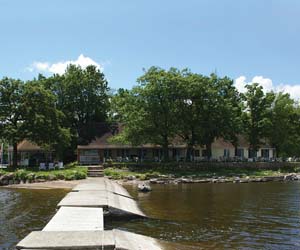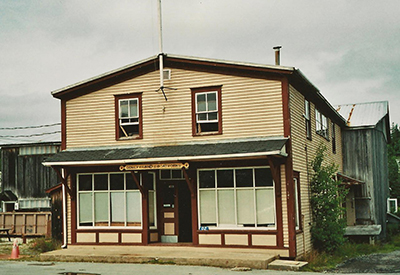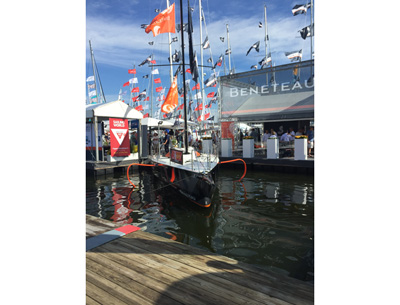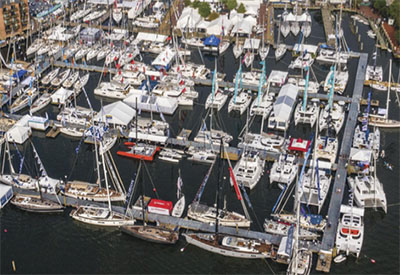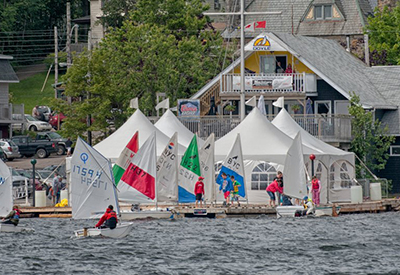Club Nautique on Petit Lac Magog
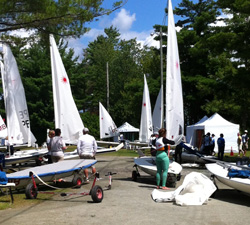
Story and Photos By Katherine Stone
Hosts of the 2013 Canada Summer Games
The power of one is a dominant proclamation that resonates within many small, casual, easy-going boating clubs throughout Canada. These boating fraternities were often started with the vision of one person, who was soon joined by others to create a community of people who loved the water and wanted to participate in outdoor activities that involved a lake. Being Canadian, they really didn’t care if the lake was in a liquid or solid form, as they would be outside enjoying the water in any state, they only needed to adapt their clothing and equipment to be happy. In the early 1960s, a few people in the tiny village of Deauville, Quebec (population just over 3,300 people in 2006) came together to form Club Nautique on beautiful Petit Lac Magog.
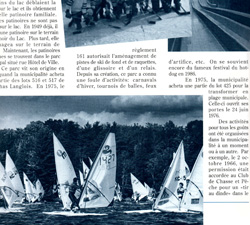 Lac Magog is located in the Eastern Townships of Quebec. It is a reservoir resulting from the construction of four dams, to generate hydroelectricity and control the level of water in the early 1900s. At the most, it is 11 km long and two km wide, which makes it challenging, but doable, to set a good decent weather leg for a sailboat race. More challenging is the fact that the average depth is only 18m. Back in 1899 there was a rock, named by the locals Gull Rock, which was some 300 feet long, situated in the middle of Petit lac Magog. When the dam at Rock Forest was built in 1911 the rock became almost completely submerged. What do you do now so that people won’t hit this almost submerged rock while boating? Simple, just build a little observation chalet with a platform right on the rock, so you can view swimming, canoeing, and sailing races!
Lac Magog is located in the Eastern Townships of Quebec. It is a reservoir resulting from the construction of four dams, to generate hydroelectricity and control the level of water in the early 1900s. At the most, it is 11 km long and two km wide, which makes it challenging, but doable, to set a good decent weather leg for a sailboat race. More challenging is the fact that the average depth is only 18m. Back in 1899 there was a rock, named by the locals Gull Rock, which was some 300 feet long, situated in the middle of Petit lac Magog. When the dam at Rock Forest was built in 1911 the rock became almost completely submerged. What do you do now so that people won’t hit this almost submerged rock while boating? Simple, just build a little observation chalet with a platform right on the rock, so you can view swimming, canoeing, and sailing races!
This striking area is part of the great watershed of the St. Francis River, which flows into the St. Lawrence River and was first populated by English, Scottish, and Irish immigrants during the 19th century. The borough of Rock Forest-Saint-Elie-Deauville (once three 3 independent towns) was formally annexed into the city of Sherbrooke in January 2002. Nearby is Mount Orford boasting an active family skiing community. Acting commodore Francois Beaulieu says that if it’s dark over Mount Orford, you have about 10 minutes before you are going to get wet on the lake! If you aren’t into sliding on snow then you might want to try sliding on ice. In Ontario we call this blue powder but the Quebecers thrive on ice and you will find them scooting across the smooth surface of the lake either kite boarding or ice boating. If sliding on water, either liquid or solid isn’t your thing, you might find fishing (both summer and winter) very appealing with pike and bass in abundance.
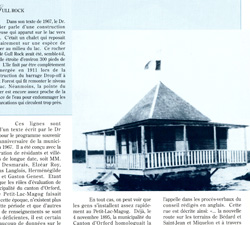 At the height of its membership, Club Nautique de Petit lac Magog (CNPLM) had 110 families who had a lot of children who used the lake for swimming, water polo, row boating, sailing, canoeing, and kayaking. They started out simply enough in people’s backyards, just like St. Margaret Sailing Club in Nova Scotia. Land was eventually purchased and a club house built for $25,000 with help from the members who were reimbursed at $1,000/year over 25 years. The sailing club now leases land to Jean Emond and his wife Michele Lariviere, who supervise the sailing, canoe, and kayak school and rental facilities four days a week during July and August. The Quebec Adapted Sailing Association chapter of the Eastern Townships has also collaborated with the yacht club to provide adapted sailboats (2.4m) for those who have athletes in wheelchairs or who are mobility challenged. This has allowed freedom for boaters from age 10-110, the ability to learn to sail and experience the freedom of leaving their wheelchairs on the dock.
At the height of its membership, Club Nautique de Petit lac Magog (CNPLM) had 110 families who had a lot of children who used the lake for swimming, water polo, row boating, sailing, canoeing, and kayaking. They started out simply enough in people’s backyards, just like St. Margaret Sailing Club in Nova Scotia. Land was eventually purchased and a club house built for $25,000 with help from the members who were reimbursed at $1,000/year over 25 years. The sailing club now leases land to Jean Emond and his wife Michele Lariviere, who supervise the sailing, canoe, and kayak school and rental facilities four days a week during July and August. The Quebec Adapted Sailing Association chapter of the Eastern Townships has also collaborated with the yacht club to provide adapted sailboats (2.4m) for those who have athletes in wheelchairs or who are mobility challenged. This has allowed freedom for boaters from age 10-110, the ability to learn to sail and experience the freedom of leaving their wheelchairs on the dock.
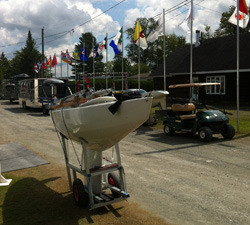 CNPLM is no stranger to hosting large scale regattas. When windsurfing was at its height – you would find many weekends with these thrill seekers packing their camper vans and heading to this mecca. Not to be outdone, they also hosted the sailing venue for the 1977 and 1994 Quebec Games. “Everyone thought we couldn’t handle the Canada Games as we were too small,” comments Commodore Beaulieu. The combination of a beautiful lake, adaptive sailing facilities, their history of running large regattas, easy access to the water, and a small, integral volunteer group who weren’t afraid to get their hands dirty, made their bid for the 2013 Canada Summer Games become a reality in July. The club members soon got to work organizing the volunteers to repaint the small cottage that they use as a clubhouse, rebuilding three small sheds, putting up tents, assembling new floating docks, and temporarily removing many club lasers and catamarans to get ready for the games. Added to that for a third season, a team of young peopl from the Ascent School (Leber) put in volunteer hours at the club by raking leaves in the spring to also help spruce up the site for the games.
CNPLM is no stranger to hosting large scale regattas. When windsurfing was at its height – you would find many weekends with these thrill seekers packing their camper vans and heading to this mecca. Not to be outdone, they also hosted the sailing venue for the 1977 and 1994 Quebec Games. “Everyone thought we couldn’t handle the Canada Games as we were too small,” comments Commodore Beaulieu. The combination of a beautiful lake, adaptive sailing facilities, their history of running large regattas, easy access to the water, and a small, integral volunteer group who weren’t afraid to get their hands dirty, made their bid for the 2013 Canada Summer Games become a reality in July. The club members soon got to work organizing the volunteers to repaint the small cottage that they use as a clubhouse, rebuilding three small sheds, putting up tents, assembling new floating docks, and temporarily removing many club lasers and catamarans to get ready for the games. Added to that for a third season, a team of young peopl from the Ascent School (Leber) put in volunteer hours at the club by raking leaves in the spring to also help spruce up the site for the games.
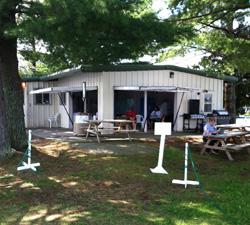 And ready they were, with smiles, bonjours, and hospitality overflowing and infecting anyone on the site! The town of Sherbrooke would like to take over the yacht club as their taxes have been in arrears for a couple of years. The club Nautique de Petit lac Magog yacht club members feel that their best contribution to this “venture” would be to maintain control of the area, yet report to the town, so that the site will not become a municipal park. Winning the Canada Games at this site has certainly made this dream more of a reality as they have shown that they are most capable.
And ready they were, with smiles, bonjours, and hospitality overflowing and infecting anyone on the site! The town of Sherbrooke would like to take over the yacht club as their taxes have been in arrears for a couple of years. The club Nautique de Petit lac Magog yacht club members feel that their best contribution to this “venture” would be to maintain control of the area, yet report to the town, so that the site will not become a municipal park. Winning the Canada Games at this site has certainly made this dream more of a reality as they have shown that they are most capable.
This cozy, well maintained yacht club offers picnic tables, free parking, preferential rates on boat rentals and courses, space to store and moor your boat, and great social activities. Members can make use of a 30% discount on the rental of different boats available on the site as well as sailing programs, and daycare. A membership will only run you about $450.00, with winter storage around $150.00, mooring $75.00 or a ground space for $150-175. Pretty good value for the money, I’d say!
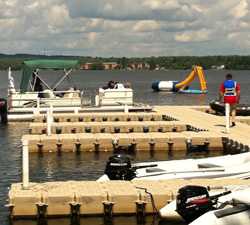 Sound like the club for you? Sharon Imbeault, website administrator, put it succinctly, “It is thanks to the perseverance of many, the audacity and talent of others, but largely due to the support and solidarity of many volunteers, members, and friends, which all have one thing in common: the love of the outdoors [and the preservation of CNPLM].”
Sound like the club for you? Sharon Imbeault, website administrator, put it succinctly, “It is thanks to the perseverance of many, the audacity and talent of others, but largely due to the support and solidarity of many volunteers, members, and friends, which all have one thing in common: the love of the outdoors [and the preservation of CNPLM].”
Club Nautique de Petit lac Magog
8683, rue Saroy
Sherbrooke, Quebec J1N 3J4; 819-864-6130
www.cnplm-magog.net
Photo Captions:
Photo 1: Youth radial, laser and 24er sailors prepare their boats for the first day of racing at Canada Games
Photos 2, 3: At the height of its membership CNPLM had 110 families who had a lot of children who used the lake for swimming, water polo, row boating, sailing, canoeing, and kayaking. Credit: Club de la petit Magog archives
Photo 4: 2.4m waiting for shipment on the driveway sporting the provincial and territorial flags
Photo 5: CNPLM newly painted clubhouse
Photo 6: Special floating docks purchased to prepare for the 2.4m sailors at the Canada Games

